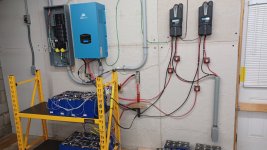Received the big 4/0 cables for the batteries and inverter connections.
Got them at https://www.batterycablesusa.com/battery-cables-ul
$290 for the 9 cables - 26' of total length. They come with whatever size lugs you specify

Got them at https://www.batterycablesusa.com/battery-cables-ul
$290 for the 9 cables - 26' of total length. They come with whatever size lugs you specify






